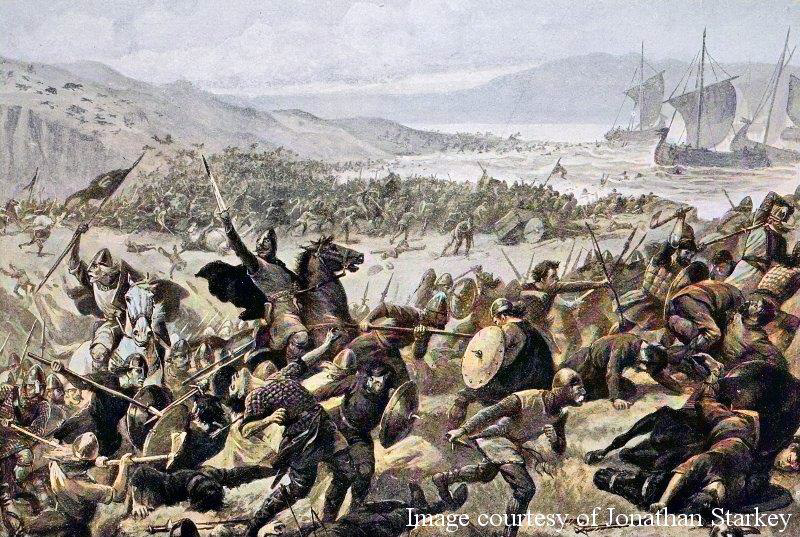
This might seem a bit far fetched but Jonathan Starkey from Buckinghamshire doesn't think so. He's currently writing a paper which puts forward a very good case for Wigan. Brunanburh is the site of one of the most important battles in English history. Although not as well known as Hastings or Bosworth, it is seen by many historians as the event that established the English State for the first time. It took place in the 10th century between King Athelstan's Anglo-Saxons and an alliance of Scottish, Northumbrians and Vikings from Ireland led by Olaf Guthfrithson. The English monarch's victory confirmed his control of the whole of England for the first time.
Nobody really knows where the battle took place - over the centuries many have speculated where it might have been (there is even a monument to the battle at Walton's Mount near Nelson). For a long time Michael Wood's view held sway suggesting that it was in the south Yorkshire area (his 'In Search of Athelstan' was first aired in 1981). In recent years though many historians have come to accept Michael Livingston's persuasive arguments for a site on the Wirral (he published his Casebook in 2011 and his 'Never Greater Slaughter' book this last year). His theories revolve around the fact that the original name for Bromborough was Brunburh which appears as early as the 11th century, only to go out of use in the 18th. He also points out the impracticality of Olaf's fleet (over 600 ships) to have sailed around Scotland to land on the east coast. Michael Wood however has not been convinced and, in a recent conference, dismissed it saying the only evidence for the Wirral site is the name. Wood himself has highlighted a site near Doncaster, based on the fact that the spelling should be with a double 'n' i.e. Brunnanburh, which implies a site near a sacred spring (you can see Wood's conference talk here).
On the other hand Jonathan Starkey argues this could also apply to Wigan, with its many spring sites (Newsprings, Springview etc.). In fact there is a Medieval reference to a holy well somewhere near the River Douglas (a Medieval well was found in excavations at the top of Millgate in the early 80s). Jonathan admits though that his theories rely heavily on the 18th century antiquarian John Whitaker, who is not the most reliable of historians (he was convinced for instance that Coccium was at Blackrod with no real evidence). There is no reason however to doubt his description of the huge battle site graveyard found on what is now the Wigan Pier basin. This was discovered when the channel was being dug out for the Douglas Navigation, in the mid 18th century. Its date however is difficult to prove - not Civil War and certainly not the 6th century as Whitaker had claimed but could possibly be 10th century. Jonathan suggests (as have others e.g. when claiming the site near Nelson) that the Vikings from Ireland used the Ribble estuary or Martin Mere (which could have been open to the sea at that time) as a landing place. It's certainly feasible as in the early Middle Ages the Ribble formed part of a major communications route between Dublin and York. Whether you agree with Jonathan's theories or not it seems Wigan may have just as much a claim as anywhere else. You can read his paper here.
Aspull Ring Ditch
As mentioned at our last meeting this site will be our priority project this year. Following on form last year's resistivity survey (see Newsletter 246) we will be hoping to carry out excavations to try to confirm what we suspect the site to be (i.e. a Bronze Age barrow). Before we start though we will be holding a project meeting to decide on the best approach and produce a project plan. If you are interested in getting involved let me know so I can let you know when the meeting will take place.
Next Meeting
Wednesday 2nd March - in our new venue, the Real Crafty on Upper Dicconson Street (7.30pm as usual). As it happens, Bromborough on the Wirral is the subject of this month's talk. Mark Adams, the former County Archaeologist for Merseyside, will be reporting on the excavations carried out there, at a place called Mark Rake. Here they discovered Neolithic, Bronze Age and Early Medieval activity. It will also be an opportunity for Mark to give us his views on the claims for this area for the battle site. At the time of the dig he was asked to look at over 400 items, discovered by local metal detectorists, from the field where it is thought the battle took place. For Mark's verdict on how much of it can be related to the Battle of Brunanbugh you'll have to wait and see. Hope to see you there B.A.
|



